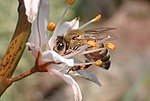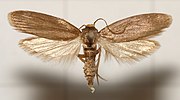from the Near East region) of Apis mellifera. The appearance of the A. m. meda greatly resembles the Apis mellifera ligustica, to such an extent that...
3 KB (344 words) - 00:34, 28 April 2024
have been described since then (Apis mellifera pomonella in 2003, Apis mellifera simensis in 2011, and Apis mellifera sinisxinyuan in 2016; see below)...
14 KB (1,613 words) - 17:20, 30 September 2024
closely related to A.m. anatoliaca and A. m. meda and belongs to the O Lineage (Oriental branch) of Apis mellifera. Kandemir, İ.; Meixner, Marina D.; Ozkan...
5 KB (409 words) - 23:10, 23 April 2024
characterization of Iranian (Apis mellifera meda), Central Anatolian (Apis mellifera anatoliaca) and Caucasian (Apis mellifera caucasica) honey bee populations"...
5 KB (497 words) - 16:53, 4 September 2023
Apis laboriosa Apis mellifera adansonii Apis mellifera artemisia Apis mellifera litorea Apis mellifera pomonella Apis mellifera meda Apis mellifera monticola...
13 KB (1,459 words) - 02:00, 11 January 2025
years in temperate climates. These mites can infest Apis mellifera, the western honey bee, and Apis cerana, the Asian honey bee. Due to very similar physical...
39 KB (4,498 words) - 19:58, 17 January 2025
affecting honey bees. While most commonly infecting the honey bee, Apis mellifera, it has also been documented in other bee species, like Bombus terrestris...
17 KB (2,226 words) - 21:17, 18 January 2025
with a drastic rise in reports of disappearances of western honey bee (Apis mellifera) colonies in North America. Beekeepers in most European countries had...
141 KB (15,786 words) - 04:51, 18 January 2025
parasite and scavenger of bee colonies, especially for honeybee colonies, Apis mellifera. The honeybee’s alarm pheromone, especially of European honeybee (EHB)...
37 KB (4,367 words) - 17:46, 3 August 2024
Apis laboriosa Apis mellifera adansonii Apis mellifera artemisia Apis mellifera litorea Apis mellifera pomonella Apis mellifera meda Apis mellifera monticola...
16 KB (1,794 words) - 11:59, 16 May 2024
of 2n=20. The Latin specific epithet meda refers to Media (a region of Persia). Similar to Apis mellifera meda (the Persian honey bee or Iranian honey...
9 KB (899 words) - 12:03, 26 November 2022
secondary pollen (at most 15%). It is produced by native "gray bees" (Apis mellifera carnica) of the Pannonian subtype. It has been produced commercially...
4 KB (425 words) - 21:45, 17 January 2025
shared genetic traits. The term "honey bee" means a bee of the species Apis mellifera which descend from bees that originated in Africa. Differences in the...
9 KB (984 words) - 05:35, 23 September 2023
Takahashi (2018). "The complete mitochondrial genome of a Buckfast bee, Apis mellifera in Northern Ireland". Mitochondrial DNA Part B. 3 (#1): 338–339. doi:10...
20 KB (2,620 words) - 05:39, 9 December 2024










